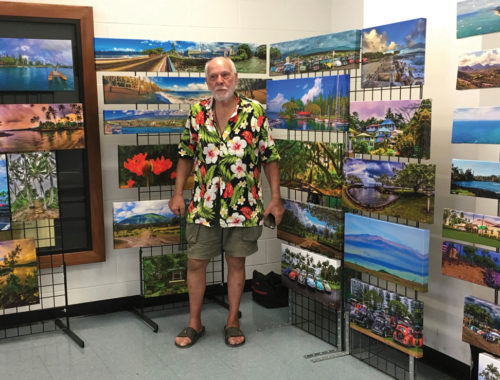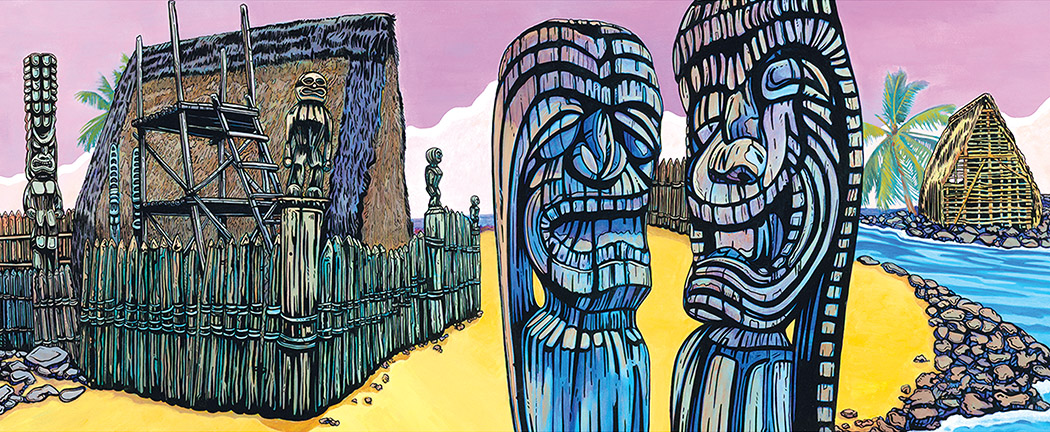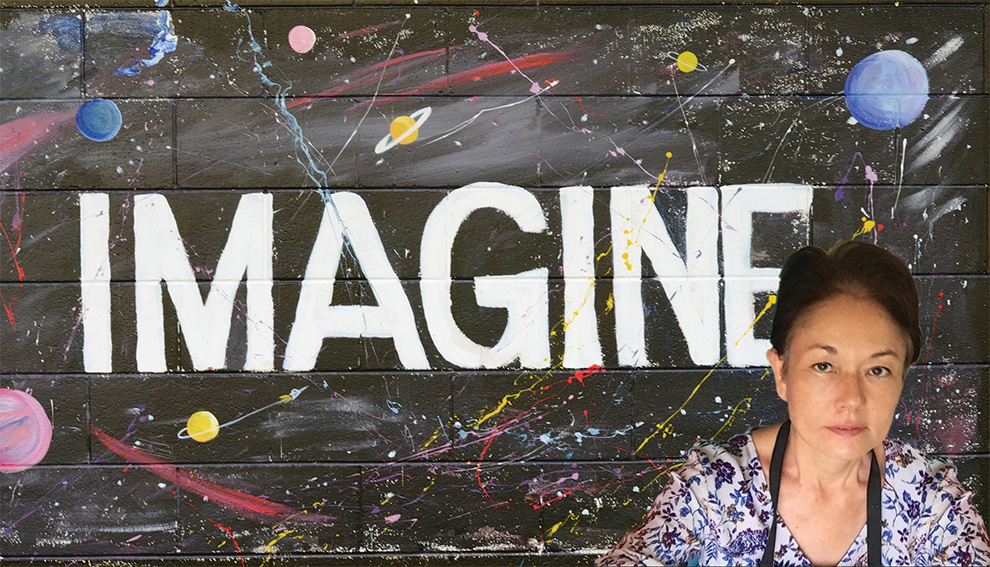
Kahakai Elementary School Art Program Leaves No Child Behind

By Karen Rose
Former Director of the National Endowment for the Arts Jane Alexander famously said, “When we teach a child to sing or play the flute, we teach her how to listen. When we teach her to draw, we teach her to see. When we teach a child to dance, we teach him about his body and about space. When we teach a child design, we reveal the geometry of the world.”
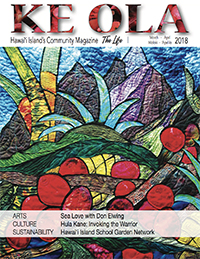
In recent years, schools across the country have cut back significantly on art programs and shifted their academic focus heavily toward common core subjects like math and reading. However, one grade school on Hawai‘i Island recognizes the importance of art education and is doing everything it can to maintain a quality program for its students.
Kahakai Elementary School in Kailua-Kona regards art education as an essential factor in the building blocks of child development. Four years ago, the school created an art program for its students with the goal of enriching their lives and educational experience.
This year, Linda Wantanabe stepped in to teach Kahakai’s art program. Although Linda has a degree in fine art, she taught various other subjects at Kahakai before recently taking over the art program.
“Not many schools have the same opportunities for students to create something with their hands anymore,” said Linda. “I think that makes our program really special. It kind of brings back how it used to be in the old days. We give our students opportunities to be creative and make something from their own ideas, which is wonderful.”
No school program is successful without the support of its leadership, and Kahakai’s school principal, Mr. Denight, felt the art program was important enough to ensure money was available to purchase a kiln and have two art teachers.
“I feel it’s important to focus on the whole student, not just on academics, but their creative side as well,” said Mr. Denight. “It’s important to expose students to art in elementary school because you never know with whom it’s going to take off. It’s extremely important that we focus on the entire child, for their development.”
“We are very lucky because not many grade schools have a kiln,” said Linda. “This enables us to incorporate ceramics into the art program and the kids seem to enjoy ceramics more than anything else we do. We also let them glaze their projects, so they get a beautiful piece when they’re done.”
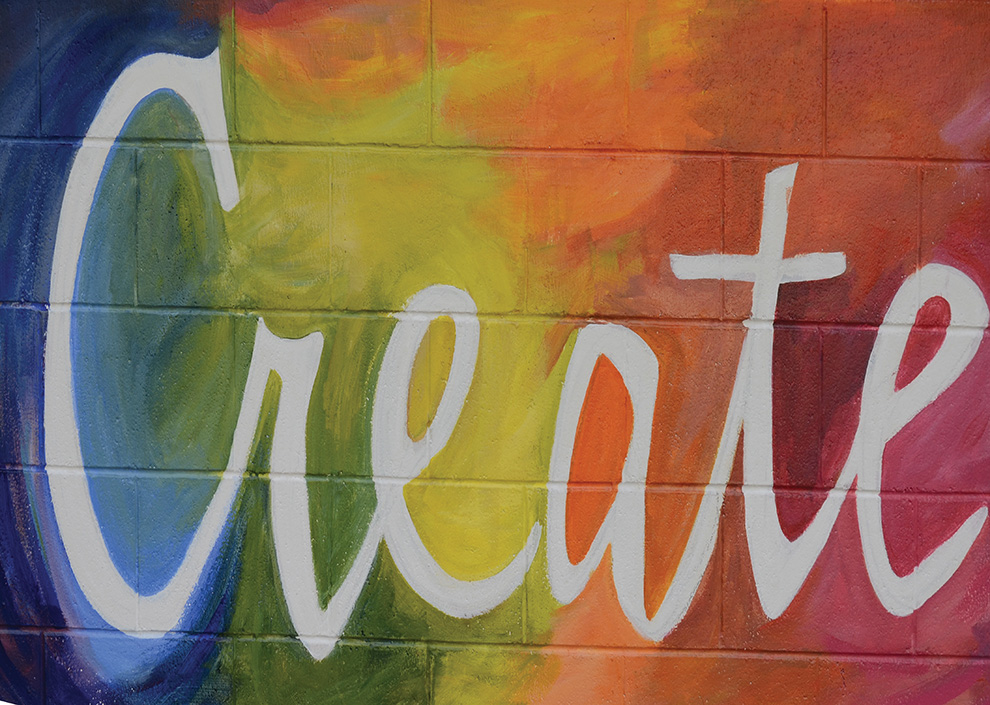
In addition to ceramics, Kahakai offers instruction in painting and drawing as well.
“We pretty much do everything,” said Linda. “It’s not the biggest classroom, but we make the most of what we have. This year we expanded the art program. Prior to this year, we did not include the lower grades, just the three upper grades. Kahakai is very committed to providing a great art program to the kids in a very big way.”
Kahakai’s commitment to the arts is supported and backed by research. According to a report by Americans for the Arts, art education strengthens critical thinking skills and improves a child’s ability to solve problems. These skills are carried with them throughout their lives. The developmental benefits of art are exponential and include skills such as visual learning, motor skills, and improved academic performance.
“Art allows children to think outside the box and try new things,” said Linda. “Even if they don’t become artists themselves, art helps them in other avenues of their life when they become adults. Instead of following the same methods to do something, kids with an art background may be more willing to try new things and do something in a unique way. I really believe it opens up their minds to different avenues. In addition to the usual way of doing things, art allows kids to create whatever it is they feel, instead of just having to follow specific instructions.”
Kahakai’s art program encourages students to express themselves through creativity, and as such, develop a sense of innovation and inventiveness. They are preparing their students for the future by encouraging them to think, invent, and discover new ways to make the world a better place.
“Our art program allows the children to have the freedom to make something unique,” said Linda. “That’s nice because their days are so regimented. They are required to have math at a certain hour and reading at another hour. But in that one-half hour period, they’re really enjoying themselves without the rigid rules of other classes. While they still have to behave in art class, they have a lot more freedom. I think that’s good. There’s very little of that free creative time anymore.”

Numerous academic studies show a correlation between art and achievement. For example, the same report by Americans for the Arts found students who regularly participated in the arts were significantly more likely to excel and be recognized in other areas of academia than children who did not practice art. Linda noticed a behavioral shift in students once they participated in the school’s art program.
“There were some kids that had a difficult time in the other classes, especially with behavioral issues,” she said. “They had a difficult time focusing and sitting still. However, those same kids, when I see them in the art room, are not like that at all. They get lost in their projects and they end up with something that’s really, really great. They have no trouble spending the whole time making something and not fooling around.”
Linda believes art class is a place where students excel and build their confidence. This confidence building often carries over to other subjects and other aspects of their lives.
“For some kids, art class is the place they can shine because they don’t have to settle down,” she said. “They can just put all that energy into creating something, and for them it may be the only time they are really in their top form. They have a place to channel their energy as opposed to causing disruption in the classroom. It’s amazing. I was like, ‘Wow, this is the same kid I had last year but look at him in here. This is a whole different scenario.’ Usually, those kids actually come up with the best work.”
Modern day students are very adept and familiar with using technology of all sorts, and while the teachers at Kahakai encourage technological learning, they also recognize the benefits of creating something with one’s own two hands.
“I can see my students thinking, ‘Oh, wow, I don’t need my iPhone. I don’t need all that stuff. I can just make something with this pile of clay’,” said Linda. “The joy they feel when they see their piece come out of the kiln is wonderful. They’re so proud of their work and they want to bring it home to their parents to share with them. It makes them feel good about themselves.”
The school’s art program is also designed to give students an opportunity to relax and temporarily escape the stresses of academia. With cuts to school art programs, having time for art class is somewhat rare in schools today. However, the students at Kahakai Elementary School dedicate 30 minutes of every day to being free and creating something they can feel good about.
“The students seem happier when they’re creating art,” said Linda. “We have several kids with difficult home lives which affect them at school. However, when they’re in the art room, they tend to forget about their stresses outside of school and are happy focusing on their art. It gives them self-confidence to create something beautiful. I really think it’s one of the best programs you could have in school.”
Kahakai is also known for the beautiful murals their students created, which now adorn the outside of the building. Former Kahakai art teacher, Susan Gallery, inspired her students to join forces and create colorful murals to display to the public.
“The former art teacher was wonderful. She had the students create some wonderful murals,” said Linda. “There is one outside the classroom now. The kids each created a small piece of the mural and then joined them all together to make one big mural.”
Students have their art work displayed inside the school as well.
“They’re very happy to see their work displayed with their names on them. They’re very proud,” said Linda. “They often bring their parents to show them their displayed work. It’s nice. It gives them a feeling of accomplishment.”

There is much to be learned from the arts, and Kahakai Elementary School’s art program is a testament to the importance of art education at every age level. In today’s diverse and often stressful world, teaching children to recognize their own creativity and the creativity of others opens their minds to the idea that what we see in the world around us, whether it is art, marketing, or advertising, may just be someone else’s interpretation of reality. Recognizing everyone’s unique ability to create and influence creates more critical thinkers, and that is something the world always needs more of. ❖
Photos courtesy of Linda Wantanabe
For more information: kahakai.me
Mahalo BMW of Hawaii – Art Story Sponsor
